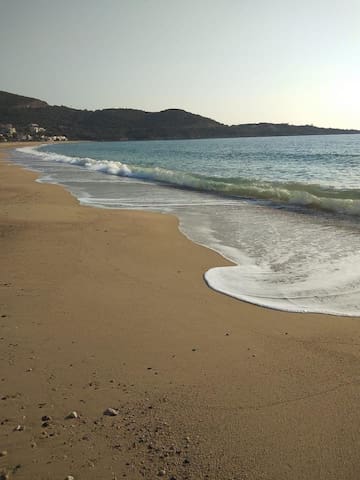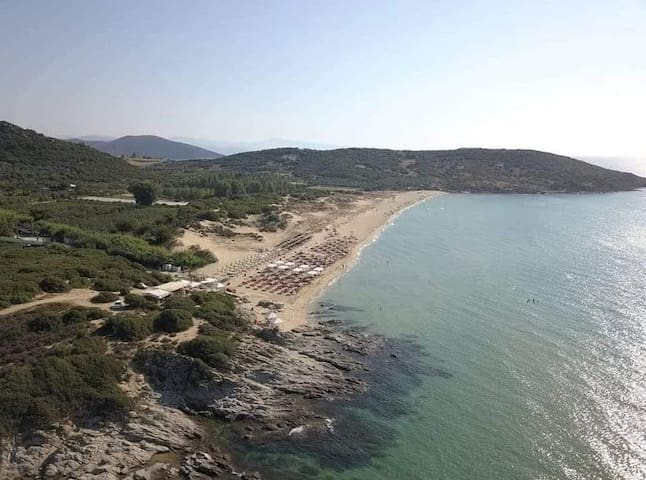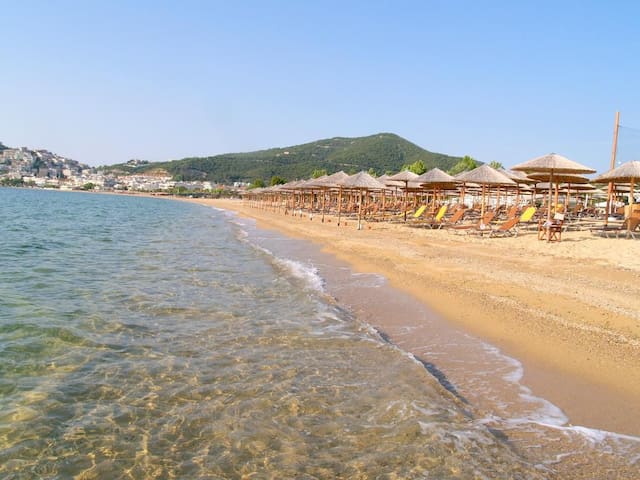Sightseeing
The city of Kavala in northern Greece, which rises up from the sea like an amphitheater, is a gem waiting to be explored for its rich history and beautiful surroundings.
This coastal city, which is home to approximately 50,000 inhabitants, is the entry point to Macedonia from the east and that’s why it is often dubbed the “Thermopyles of Macedonia”.
Split among the Palia Poli (Old town) and the Nea Poli (New town) Kavala is situated on the Bay of Kavala, across from the island of Thassos and on the Egnatia motorway, a one-and-a-half-hour drive east of Thessaloniki.
In antiquity the name of the city was Neapolis (meaning “New city”, like many Greek colonies). During the Middle Ages, it was renamed Christoupolis (“City of Christ”). For centuries it was part of the Ottoman empire before being briefly occupied by Bulgaria in the beginning of the 20th century.
Kavala pictured circa 1940. Source: Wikipedia
After the Greco-Turkish War of 1919–1922, the city entered a new era of prosperity because of the labor offered by the thousands of refugees who had moved to the area from Asia Minor. The development was both industrial and agricultural.
Kavala became known for the processing and trading of tobacco. Many buildings related to the storage and processing of tobacco from that era are preserved in the city.
Top things to see and do
The castle
The arsenal and the food storage buildings inside the castle. Source; Wikipedia
From the 5th century BC onward, the city of Kavala was surrounded by a defensive wall. A major modification took place in 1307 during the reign of Andronicos II Palaeologos, when the long walls from the sea to the top of the hill were built.
The Byzantine castle was completely destroyed in 1391 when the Turks captured the city. The castle was rebuilt by the Ottomans in 1425 and what we see today is mostly the result of that reconstruction.
The aqueduct
The Kavala aqueduct, popularly known as the Kamares, is a well-preserved structure in the city of Kavala and is understandably one of the city’s landmarks. While the aqueduct is considered most likely of Roman origin, the present structure dates to the 16th century.
Tobacco Museum
From the mid-19th century until 1950, Kavala was the largest center for the processing and exporting of tobacco in the Balkans. The uniqueness of the Museum lies in the fact that not only does it contain an exhibition on the processing of Oriental tobaccos (which are not found in any other museum in the world), but also in the fact that it is a museum that showcases the economic and social history of the region.
Municipal Tobacco Warehouse
The Municipal Warehouse is one of the most interesting buildings in Kavala. It housed the company of Kiazim Emin & Cie and was built in 1910 by the businessman and tobacco merchant Kiazim Emin.
The building has an Ottoman design in a style that is known as “Ottoman neoclassicism,” with a strong influence from the neoclassical architecture of Europe.
Wander around the Old Town
Walk through the picturesque lanes of the Old Town, in the peninsula of Panagia, which looks as though it has jumped out from the illustrated pages of a fairy-tale book.
The imaret
In the early 19th century Mohammed Ali, founder of the last Egyptian dynasty, established an Imaret – a religious, educational and charitable institution – in his hometown of Kavala. It functioned as an Islamic seminary until 1902, as from 1846 onward, the education of Muslims included instruction in religion.
Via Egnatia
The military Roman road called “Via Egnatia” passed through the city and helped commerce to flourish in the area. Kavala became a Roman “civitas” in 168 BC, and served as a base for Brutus and Cassius in 42 BC, before their defeat in the Battle of Philippi.
The Apostle Paul landed at Kavala on his first voyage to Europe.
Explore Philippi
The UNESCO World Heritage Site of Philippi, just a few miles away from Kavala, is connected to many exceptional historical figures and events which shaped the Western world. Stunning monuments, which still survive today, are evidence of the long history of the cultures which interacted and flourished in this region.
A dip in the blue-green seas
Serene waters, sandy beaches, huge coastlines, tavernas next to the waves, sport activities – the beaches of Kavala have it all. The most popular are Batis, Tosca, Kalamitsa, Rapsani and Perigiali.
Escape to beautiful Thassos
Limenas, or the port, of Thasos, the capital of the island. Source: Wikipedia
Kavala is the ideal base for a brief escape to one of the most beautiful islands in Greece, verdant Thassos. Surrounded by the crystal blue waters of the Aegean Sea, you can immerse yourself in a breathtaking natural environment and experience a laid-back culture which warmly welcomes every visitor.
53 locals recommend
Kavala
3 Erithrou StavrouThe city of Kavala in northern Greece, which rises up from the sea like an amphitheater, is a gem waiting to be explored for its rich history and beautiful surroundings.
This coastal city, which is home to approximately 50,000 inhabitants, is the entry point to Macedonia from the east and that’s why it is often dubbed the “Thermopyles of Macedonia”.
Split among the Palia Poli (Old town) and the Nea Poli (New town) Kavala is situated on the Bay of Kavala, across from the island of Thassos and on the Egnatia motorway, a one-and-a-half-hour drive east of Thessaloniki.
In antiquity the name of the city was Neapolis (meaning “New city”, like many Greek colonies). During the Middle Ages, it was renamed Christoupolis (“City of Christ”). For centuries it was part of the Ottoman empire before being briefly occupied by Bulgaria in the beginning of the 20th century.
Kavala pictured circa 1940. Source: Wikipedia
After the Greco-Turkish War of 1919–1922, the city entered a new era of prosperity because of the labor offered by the thousands of refugees who had moved to the area from Asia Minor. The development was both industrial and agricultural.
Kavala became known for the processing and trading of tobacco. Many buildings related to the storage and processing of tobacco from that era are preserved in the city.
Top things to see and do
The castle
The arsenal and the food storage buildings inside the castle. Source; Wikipedia
From the 5th century BC onward, the city of Kavala was surrounded by a defensive wall. A major modification took place in 1307 during the reign of Andronicos II Palaeologos, when the long walls from the sea to the top of the hill were built.
The Byzantine castle was completely destroyed in 1391 when the Turks captured the city. The castle was rebuilt by the Ottomans in 1425 and what we see today is mostly the result of that reconstruction.
The aqueduct
The Kavala aqueduct, popularly known as the Kamares, is a well-preserved structure in the city of Kavala and is understandably one of the city’s landmarks. While the aqueduct is considered most likely of Roman origin, the present structure dates to the 16th century.
Tobacco Museum
From the mid-19th century until 1950, Kavala was the largest center for the processing and exporting of tobacco in the Balkans. The uniqueness of the Museum lies in the fact that not only does it contain an exhibition on the processing of Oriental tobaccos (which are not found in any other museum in the world), but also in the fact that it is a museum that showcases the economic and social history of the region.
Municipal Tobacco Warehouse
The Municipal Warehouse is one of the most interesting buildings in Kavala. It housed the company of Kiazim Emin & Cie and was built in 1910 by the businessman and tobacco merchant Kiazim Emin.
The building has an Ottoman design in a style that is known as “Ottoman neoclassicism,” with a strong influence from the neoclassical architecture of Europe.
Wander around the Old Town
Walk through the picturesque lanes of the Old Town, in the peninsula of Panagia, which looks as though it has jumped out from the illustrated pages of a fairy-tale book.
The imaret
In the early 19th century Mohammed Ali, founder of the last Egyptian dynasty, established an Imaret – a religious, educational and charitable institution – in his hometown of Kavala. It functioned as an Islamic seminary until 1902, as from 1846 onward, the education of Muslims included instruction in religion.
Via Egnatia
The military Roman road called “Via Egnatia” passed through the city and helped commerce to flourish in the area. Kavala became a Roman “civitas” in 168 BC, and served as a base for Brutus and Cassius in 42 BC, before their defeat in the Battle of Philippi.
The Apostle Paul landed at Kavala on his first voyage to Europe.
Explore Philippi
The UNESCO World Heritage Site of Philippi, just a few miles away from Kavala, is connected to many exceptional historical figures and events which shaped the Western world. Stunning monuments, which still survive today, are evidence of the long history of the cultures which interacted and flourished in this region.
A dip in the blue-green seas
Serene waters, sandy beaches, huge coastlines, tavernas next to the waves, sport activities – the beaches of Kavala have it all. The most popular are Batis, Tosca, Kalamitsa, Rapsani and Perigiali.
Escape to beautiful Thassos
Limenas, or the port, of Thasos, the capital of the island. Source: Wikipedia
Kavala is the ideal base for a brief escape to one of the most beautiful islands in Greece, verdant Thassos. Surrounded by the crystal blue waters of the Aegean Sea, you can immerse yourself in a breathtaking natural environment and experience a laid-back culture which warmly welcomes every visitor.
At Nea Irakleitsa, you will find a picturesque harbour framed by one of the most beautiful little villages in the region. Wonderful turquoise seas, with sandy beaches, tavernas, cafes and many beach bars for refreshing breaks, in case you want to spend your whole day there. The beach has some organised facilities and a free car park. You can also get hereby taking the long distance bus for Nea Peramos.
Look for “Alana”! Here you will find a beach bar and be able to play beach volley and beach tennis.
Useful information
Distance from Kavala
14 km
Blue Flag
Yes
Access for people with special needs
No
Ticket price
Free entry
Parking
Free parking area
Changing rooms
Yes
Showers
Yes
Sea activities
Sports areas and sea activities
Cafe/bar
Yes
Rooms for rent
Yes
Διαβάστε περισσότερα: https://www.visitkavala.gr/en/sightseeing/nea-iraklitsa/
34 locals recommend
Nea Iraklitsa
33 MakedoniasAt Nea Irakleitsa, you will find a picturesque harbour framed by one of the most beautiful little villages in the region. Wonderful turquoise seas, with sandy beaches, tavernas, cafes and many beach bars for refreshing breaks, in case you want to spend your whole day there. The beach has some organised facilities and a free car park. You can also get hereby taking the long distance bus for Nea Peramos.
Look for “Alana”! Here you will find a beach bar and be able to play beach volley and beach tennis.
Useful information
Distance from Kavala
14 km
Blue Flag
Yes
Access for people with special needs
No
Ticket price
Free entry
Parking
Free parking area
Changing rooms
Yes
Showers
Yes
Sea activities
Sports areas and sea activities
Cafe/bar
Yes
Rooms for rent
Yes
Διαβάστε περισσότερα: https://www.visitkavala.gr/en/sightseeing/nea-iraklitsa/
Ammolofoi Beach
The most beautiful beach in northern Greece
Nea Iraklitsa
33 MakedoniasAmmolofoi Beach Bars
Ammolofoi is the most famous beach in northern Greece . There are many beach bars offering sun beds and umbrellas with minimum consumption Peponi and la Rocca are among the best
La Roca Beach Bar
Beach Bar Peponi
Essentials
Lidl
MakedoniasJust 400meters away from Villa Kyriaki
General Hospital of Kavala
Pharmacy Iliana Kazopoulou
28is OktovriouFood scene
For Greek traditional dishes or just for greek traditional see foods with ouzo or tsipouro
Pizza or pasta
RECOMMENDED !!! Visit Stelios and order either the preferred see food dishes or grilled fish Stelios will prepare for you the dishes and you collect them .
Do not forget to try all the cooked sea dishes such as midopilafo soupies with spinach etc
Ιχθυοπωλείο-Ψητοπωλείο "Ο ΣΤΕΛΙΟΣ" (fish and grill)
RECOMMENDED !!! Visit Stelios and order either the preferred see food dishes or grilled fish Stelios will prepare for you the dishes and you collect them .
Do not forget to try all the cooked sea dishes such as midopilafo soupies with spinach etc
Porto Aris Kafe
44 Μ.ΑλεξανδρουΚρεοπωλείο Βεργουδης Απόστολος
Cafe Electra
Στου Σαρρή
5 Meg. AlexandrouGreek Reastaurant
https://www.facebook.com/stousarri
Traditional Greek Food
https://www.facebook.com/%CE%A3%CF%84%CE%BF%CF%85-%CE%BA%CF%85%CF%81-%CE%9C%CE%B9%CF%87%CE%B1%CE%BB%CE%B7-385788318566000/
Στου Κυρ' Μιχάλη
Traditional Greek Food
https://www.facebook.com/%CE%A3%CF%84%CE%BF%CF%85-%CE%BA%CF%85%CF%81-%CE%9C%CE%B9%CF%87%CE%B1%CE%BB%CE%B7-385788318566000/
Things to do
Enjoy the area by renting a boat discovering the beautiful sandy beaches Live the experience of hiking
Kavala Yachting - Sailing Yacht Charter in Kavala
Get Boat
NikisAquaholics Diving Center
1 28is OktovriouIraklitsa Fishing Trips
Traveler advice
Don't miss
23 of August Church festival In Nea Iraklitsa
3-5 Days of open market bazaar
Ways to save
Organized beach bars
Sun beds and sun umbrellas are free with just a minimum consumption of a coffee or a juice
Don't miss
PLANET
The nature loving club PLANET of Paggaio municipality, organizes one day hiking tours. Go with them to live the experience of hiking on Nea Iraklitsa trails with seaview or on the green path of Mesoropi with plenty of running water .Contact to Chris : 00306959349211



